Welcome to the Magic Folder System
ODS-Briefcase extends the concept of a simple filesystem by introducing dynamic folder types. These "magic folders" can automate tasks, integrate with external services, and provide powerful, data-driven views of your content. This documentation explores the different folder types and how they can supercharge your workflow by breaking down data silos and enabling fine-grained, decentralized access control.
Taking Control of Your Cloud Data
Modern cloud storage services (like Google Drive, Dropbox, etc.) are convenient but create centralized data silos with inconsistent security models. ODS-Briefcase solves this by providing a powerful abstraction layer.
The Problem: Centralized Silos
Each cloud service has its own proprietary API, identity system, and permission model. This makes it difficult to manage access consistently and prevents you from truly owning your data's access policies.
The Solution: A Decentralized Access Layer
ODS-Briefcase uses **Dynamic Extended Type (DET) Folders** to "mount" your external cloud storage accounts. These folders act as a bridge, allowing you to interact with all your disparate storage services through a unified interface that supports open standards like WebDAV and Linked Data Protocol (LDP).
Most importantly, this allows you to apply a single, powerful access control system across all your mounted folders. By using **WebID-based Access Control Lists (ACLs)**, you can define granular permissions for users and groups, regardless of the underlying storage service's limitations. You regain control, ensuring that only the right people can access your data, under your terms.
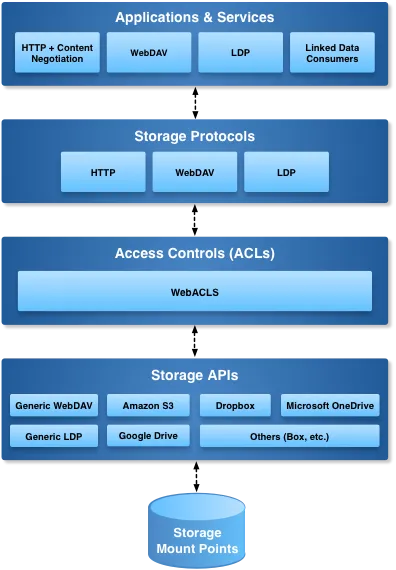
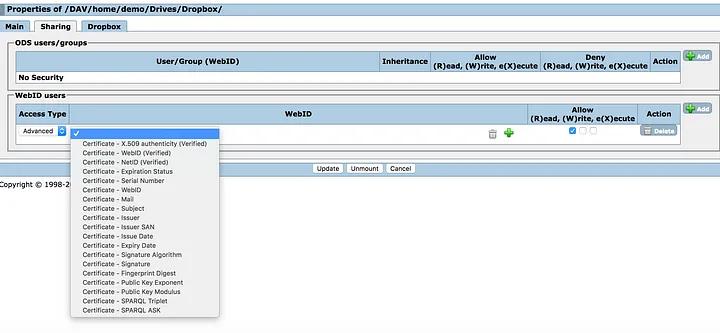
Normal Folder
The standard, everyday folder for basic file storage. Use this for general-purpose organization within your Briefcase.
How to create:
- Navigate to your Briefcase and click the "New folder" icon.
- In the creation dialog, select "Normal" from the folder type dropdown.
- Enter a name for your folder and click "Create".
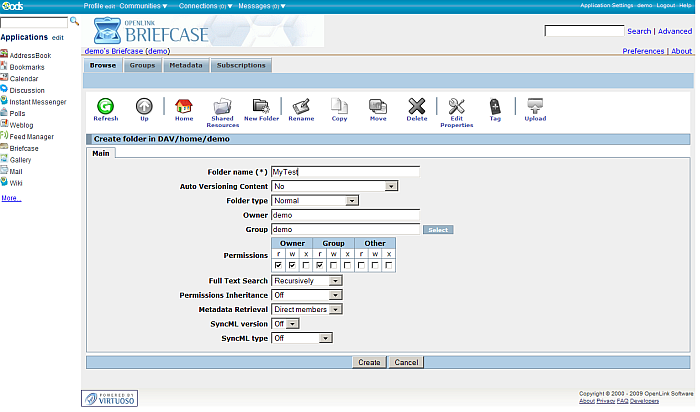
Smart Folder
A dynamic folder that automatically displays files matching specific search criteria you define. It's a saved search that acts like a folder.
Example: Show files starting with "kidehen"
- Create a new folder, select type "Smart Folder", and name it (e.g., "smart").
- Go to the "Criteria" tab. Set the Field to "File Name", Condition to "starts with", and value to "kidehen". Click "Add".
- Click "Create".
- Upload a file named "kidehen.vcf" anywhere in your Briefcase.
- Open your "smart" folder. The "kidehen.vcf" file will be listed automatically.

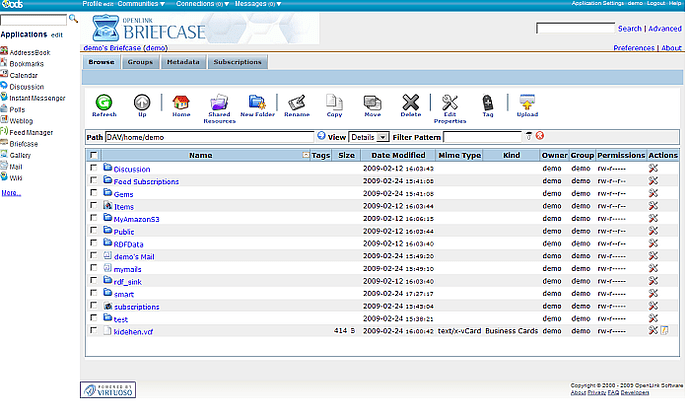
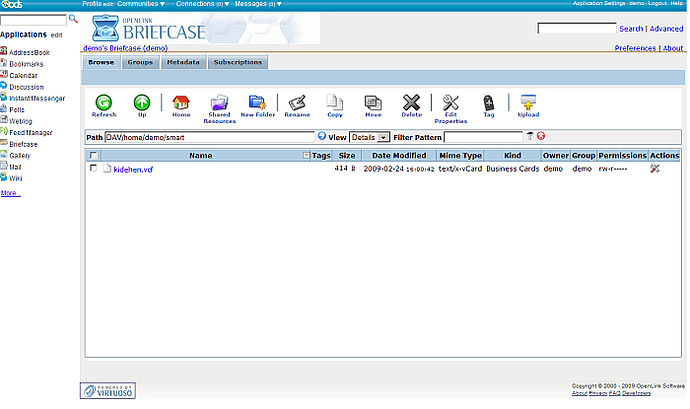
Category Folder
This folder type automatically organizes and displays a list of all category folders available in your Briefcase.
How to use:
- Create a new folder and select "Category Folder" as the type.
- Give it a name and click "Create".
- Opening this folder will present a browsable list of your content categories.
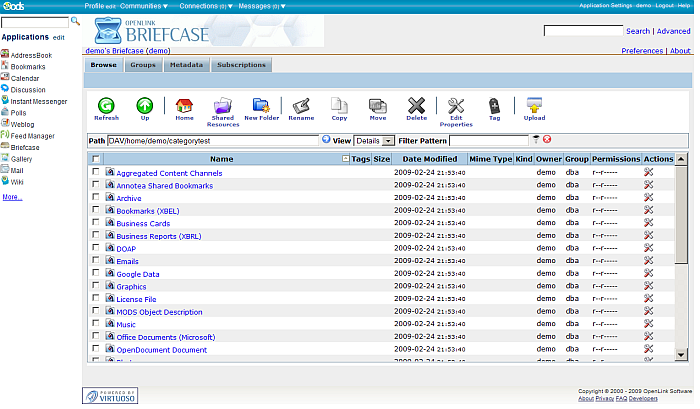
Property Filter Folder
Creates a view that shows only files matching a specific WebDAV property and value that you set.
Example: Filter by property "OpenLink: Kingsley"
- Create a folder with type "Property Filter Folder".
- In the "Filter" tab, set "Property name" to "OpenLink" and "Property value" to "Kingsley". Click "Create".
- Upload any file and add the WebDAV property "OpenLink" with the value "Kingsley" to it.
- The file will now appear in your property filter folder.


Host FS Folders
Mirrors the content of a physical folder on the server's file system directly into your Briefcase.
How to use:
- Ensure a subfolder exists within the physical location of your Virtuoso database file (e.g., a folder named "tmp").
- In Briefcase, create a new folder with type "Host FS Folders" and name it "tmp".
- The new folder will now display the contents of the physical "tmp" folder from the server.
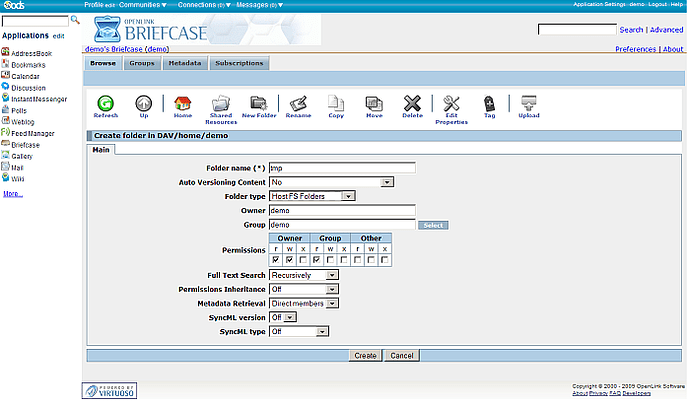
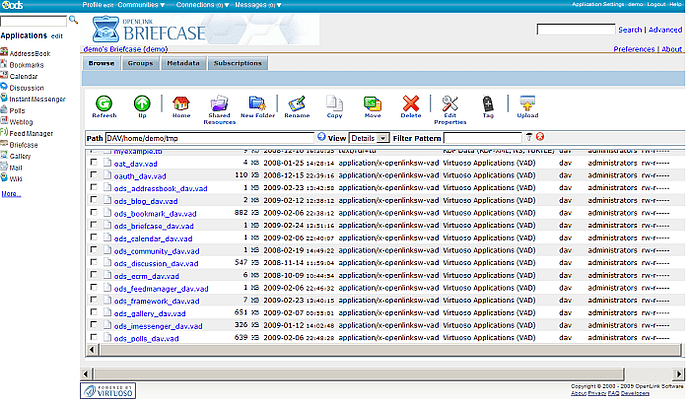
WebMail Folder
Connects to an ODS WebMail instance and displays its emails directly within your Briefcase.
How to set up:
- Create a new folder and select type "WebMail".
- In the "WebMail" tab, configure the oMail domain, folder name (e.g., Inbox), and name format.
- Once created, the folder will sync and display the emails from the specified WebMail account folder.
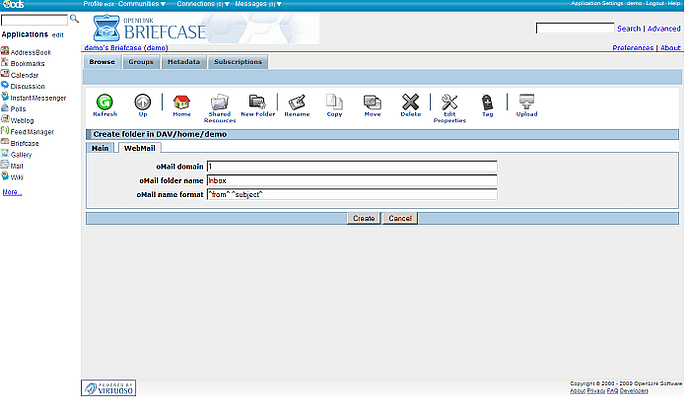
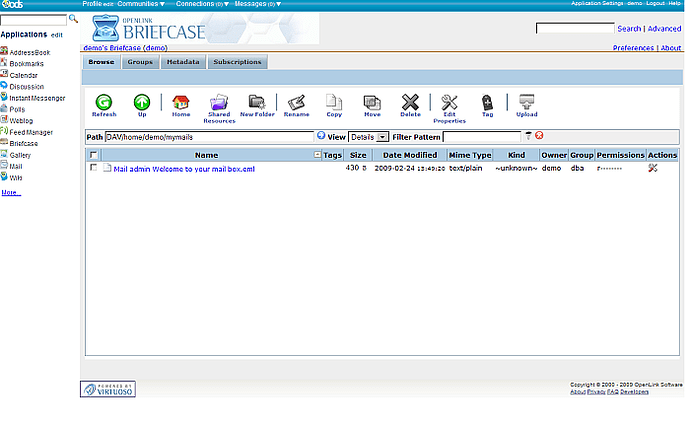
OFM Subscriptions
Collects and displays items from your RSS/Atom feed subscriptions in the ODS Feed Manager.
How to use:
- Create a folder with type "OFM subscriptions".
- Go to the ODS Feed Manager and subscribe to a feed (e.g., an RSS feed from a blog).
- The Briefcase folder will automatically populate with the items from your subscribed feeds.
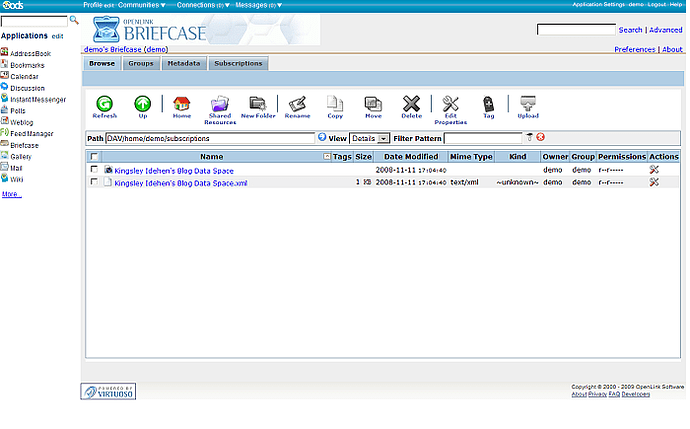 Learn More about Feed Manager
Learn More about Feed Manager
RDF Upload Folder
A specialized folder that acts as an "RDF sink", allowing you to upload RDF files and have them processed into a specified graph.
When creating this folder, a new "RDF Upload" tab appears, letting you specify the target Graph Name and toggle the Sponger service.
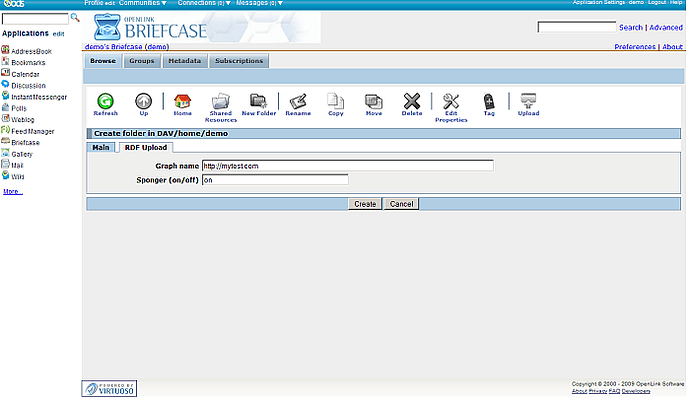 View RDF Sink Tutorial
View RDF Sink Tutorial
RDF Data
An RDF DET (Dynamic Extensible Type) folder. It collects data for a given DET with a specified graph and includes URL rewrite rules for ODS redirects and describing ODS IRIs.
Linked Data Import
A folder designed to facilitate the import of Linked Data into your Virtuoso instance.
Cloud Service Integrations
Connect your ODS-Briefcase to popular cloud storage providers. Create a dedicated folder type for each service to seamlessly browse and manage your cloud files under a unified, secure access control layer.
Amazon S3
Mounts your Amazon S3 buckets, enabling fine-grained access control via WebID ACLs.
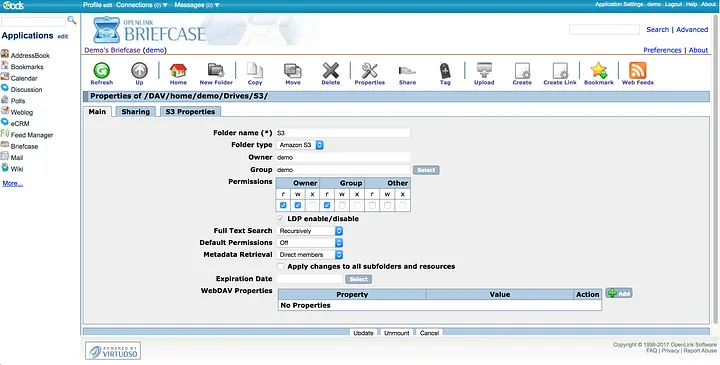 View Tutorial →
View Tutorial →
Box.net
Integrates with your Box.com account, allowing for unified access control policies.
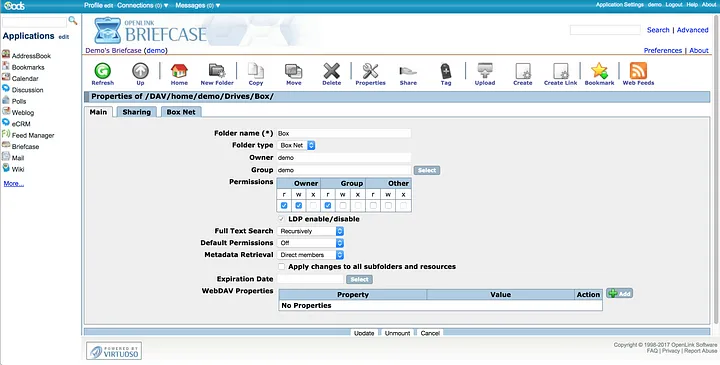 View Tutorial →
View Tutorial →
DropBox
Access your DropBox files and folders under the ODS-Briefcase security umbrella.
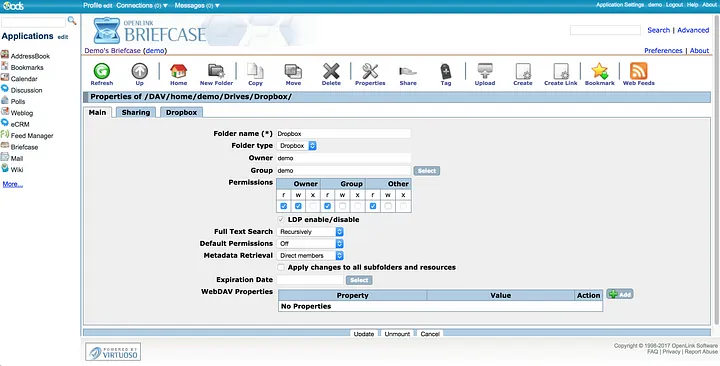 View Tutorial →
View Tutorial →
Google Drive
Connects to your Google Drive, enabling consistent, policy-driven access control.
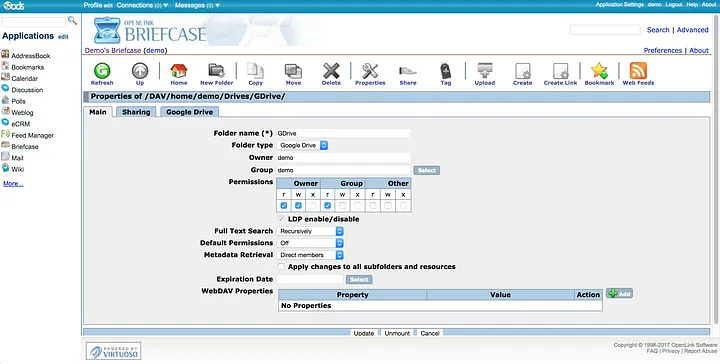 View Tutorial →
View Tutorial →
Microsoft OneDrive
Integrates with Microsoft OneDrive for unified file access and security.
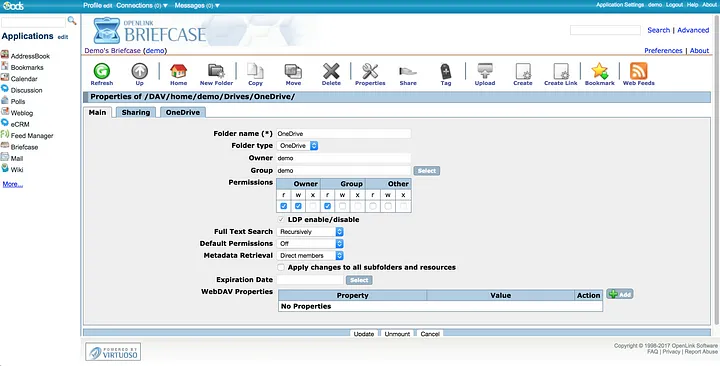 View Tutorial →
View Tutorial →